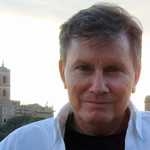“SESSHIN ARIMASSS!”
Whack!
A monk hits me with a wooden stick, hard. I’m wondering why I didn’t bring those padded shoulder jackets from the 80s. Usually, only those that doze off in meditation gets hit, but during this special time, known as sesshin, everyone gets whacked. It’s a “friendly” reminder to pull our focus back on our breath, just in case it has wandered since we first sat on our cushions at 4:00 in the morning.
For the next seven days, from 4:00 am to 9:30 pm, we meditate. Monks and serious Zen practitioners have traveled from all over Japan, their black cushions in hand, to practice with us. There are no introductions, as there’s no speaking. The same goes with reading, writing, showering, leaving the temple grounds, and using more than a few watts of electricity.
It was hard. By the second hour, my knees were throbbing, and my feet would turn numb. Emotions came and went, up and down, happiness, boredom, peace, fear, excitement, frustration. Sometimes, the more I tried to focus on my breath, the more it would run away. My mind would be spiraling in thoughts. “I’m just sitting in front of a wall for hours, what am I doing with my life?” It would ask. “What is your plan for the future?” I would catch myself desperately waiting for the bell to signal the end of the meditation session.
On the third day, however, something happened in the afternoon. It was like I was melting into some sort of primordial state—no thoughts, I was just there. The birds were chirping outside and the dry wings of insects were zipping through the wind. I heard cars rushing outside, but I only heard the sound that came and went. I did not think, “car.” This is what it must have felt like when I was in my mother‘s womb, I now think. Then, I felt a heaviness in front of me, as if a large sac of energy was circulating in an unfinished circle. With every breath, it was like I was meeting the innermost part of my being and giving it a handshake, saying “nice to meet you.”
In between sits, I would stroll along the long cemetery grounds of the temple. Since I couldn‘t do anything else, I would just observe. In a cemetery, a place where you would think death pervades, I started noticing small flashes of new life breaking through. At one moment, i saw a butterfly literally just come out of its cocoon. It couldn‘t even fly with its soft new wings yet; it was just clinging to its old caterpillar shell, as if it was waking from a long sleep. I don‘t know what to make of that moment, but for me it was a testament to the constant interplay of gestation, birth, metamorphosis, and death that underlies the workings of this incomprehensible world, a world that is kind and generous. I know there is tremendous suffering in this world that I can‘t justify with any explanation. Maybe I am an inherent cynic, but I am also astounded, perhaps even more amazed, that there is beauty in this world. Mothers giving birth to healthy babies. The rain. Creativity. Friendship. For me, those elements of our existence seem to break all odds of probability and are in themselves, miracles.
My favorite part of the day was in mid-afternoon, when the monks would serve us a small cup of tea and a sweet. One time, the head monk popped a whole red bean sticky rice bun into his mouth, chewing with his cheeks puffed out like a hamster. I was dying. It was so hard not to fall over my cushion in laughter.
Then, they would play a tape recording of their teacher’s words. The teacher now has Parkinson’s, so they play his teachings from thirteen years ago. I’m generally skeptical about spiritual teachers, but here, I felt a rare balance of humility and wisdom. He now lives in a small house on the temple grounds, under what some would consider a vegetative state. But once, his caretaker wheeled him out on a sunny day with blue skies. I looked into his eyes and met someone so in touch with life, with what we have forgotten. I still think about his words today. “Once you have nothing, you have everything,” he said, with a voice that had the resonance of aged wood, slightly petrified. Then he gave a long, drawn out breath.
So we’d sit in our places, in the wooden meditation hall, from the day‘s third hour to the third before its close when the old monk grumbles the Shiguseiganmon. I came out of that experience changed, in a fundamental way, but in one I can’t really articulate. I discovered there’s something inside, worth looking into. It is not a thought, but a pure feeling—pure assurance that everything’s alright, pure trust. And what I discovered is it never goes away. It is always there, kindly sustaining you.





